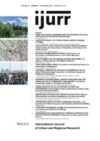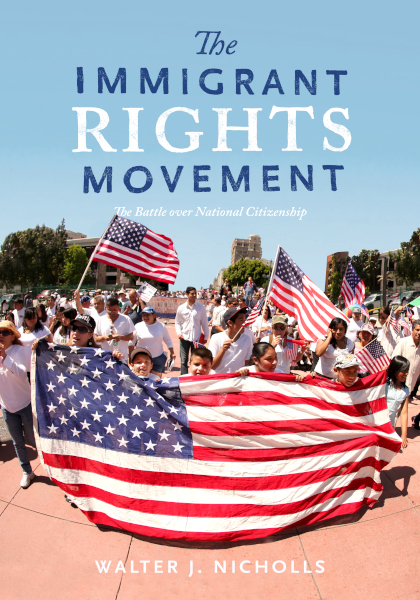Immigrant rights activism across the globe has intensified and become more networked and visible over recent years. Critical border and citizenship studies have increasingly stressed the agency of immigrants, even of those classified as ‘illegal’ by the category-making of the nation state. At the same time, migration policy scholars have (re)discovered the local level and its role in shaping the dynamics of incorporation and contestation. Some of those working on the multilevel governance of migration in a European context even point to a ‘local turn’, stressing the relevance of local governance in both immigration and immigrant policy-making. This often involves researchers expanding their horizons by moving away from traditional cities of immigration and zooming in on less diverse rural and suburban areas.
In recent years, Walter Nicholls, Professor of Urban Planning and Public Policy at the University of California, Irvine, has made a central contribution to our understanding of cities and social movements, often focusing on the United States or taking a cross-national perspective. While previous publications expanded our understanding of the spatialities of social movements or scrutinized the undocumented immigrant youth movement, this timely monograph analyses how the fight for immigrant rights became a national social movement in the United States. Taking day labourers and the urban roots of their social movement as its starting point, this compellingly written book traces their fight from its local beginnings via regional networks to the national level.
The book’s first part introduces the reader to the early struggles in the late 1980s and early 1990s, when immigrant day labourers moved into the suburbs. Searching for jobs on public street corners, they became the targets of aggrieved locals and policy attempts to bar these undocumented immigrants from settling. Many localities passed restrictive measures to ban street vending, the use of foreign languages in public records and soliciting work in public. Even though these hostile policies were directed at undocumented immigrants, they negatively affected already established immigrants and prompted citizens to feel solidarity with them.
As Nicholls convincingly illustrates, this ‘tangling’ of documented and undocumented lives turned localities into breeding grounds for new discourses and practices of citizenship. He maintains that these geographically scattered movements of amateur activists produced a plethora of ‘undisciplined’ rights claims, drawing from the often inconsistent post-national, liberal national and territorial personhood frames.
However, since real power over immigration policy was concentrated at the federal level, the immigrant rights movement felt compelled to nationalize in the mid-2000s. The new leadership, Nicholls observes, moved the struggle upwards and invested heavily in a professional campaign infrastructure. What is more, entering the national arena required an enormous effort to rationalize and harmonize the movement’s discursive claims to rights.
The second part of the book addresses a time frame beginning in the early 2000s and ending with the last years of the Obama administration, with the final chapter concluding ‘where we stand’ (p. 215) during the Trump administration. Even though Nicholls does not intend to make any recommendations concerning strategies, discourses or organizing models, his empirically rich book shines a light on the dilemmas faced when going national. Paradoxically, in fighting for inclusion, immigrant rights advocates perpetuated dominant notions of national citizenship by fuelling narratives of deservingness. Hence, although the immigrant rights movement became, according to Nicholls, one of the best-organized movements in the country, this development produced cleavages within the movement that eventually led to the formation of an influential left flank.
While most chapters are essentially empirical, Nicholls draws on various theoretical traditions such as resource mobilization theory from social movement studies, citizenship theory and migration studies. Readers interested in these conceptual considerations will find chapter 1 particularly gripping. What stands out in this work is the informed findings and the inspiring variety of data collection methods. These are briefly specified at the beginning of each chapter and explained more comprehensively in the appendix.
Among others, the author and his research assistant have built up a database based on more than 1,500 newspaper articles. This day-labour database, which facilitates a claims analysis of local conflicts across the country, provides a bird’s-eye view that is complemented by in-depth studies of local and regional movements in the Los Angeles area. Case studies build impressively on the document analysis of historical records and semi-structured interviews. The second part of the book reconstructs the nationalization of the movement by again drawing on an impressive range of qualitative methods. These comprise (but are not limited to) a second newspaper database, documents on the infrastructure of the movement, and financial information gained from a plethora of grant information provided by the New York-based Foundation Center. Furthermore, Nicholls interprets the White House database that documents visits by immigrant rights advocates in order to grasp their degree of access.
This is a well-researched contribution on the mobilization of immigrant rights activism at the intersection of social movement, urban, migration and citizenship studies. In particular, the historical, finely detailed reconstruction of the movement’s early development draws the reader in. The empirical chapters with their thick description of the case studies should be particularly intriguing for readers with a US-American research interest. For readers more familiar with the reluctant European countries of immigration, some findings about the strength of the movement and its social embeddedness may be striking. The right to work invoked by early activists presented in Nicholls’ book seems to resonate less with discourses in European welfare states. The notion of being able to recruit and exclude workers or to protect national labour markets from the influx of refugees seems more dominant here. Moreover, the density of even the early networks that the author spotlights is impressive. This is an easily accessible yet profound account that can be recommended to migration and social movement scholars alike.
Sybille Münch is a guest scientist at the Institute of Political Sciences, at Leuphana University, Lüneburg.
Walter J. Nicholls. The Immigrant Rights Movement: The Battle Over National Citizenship. Redwood City, CA: Stanford University Press, © 2019. Cover used with permission of Stanford University Press.
Views expressed in this section are independent and do not represent the opinion of the editors.

